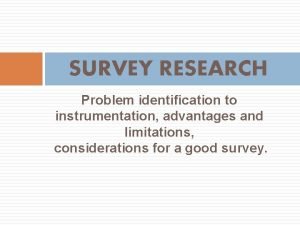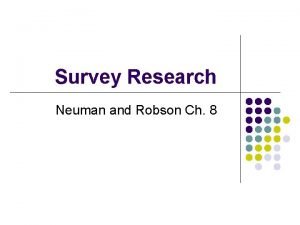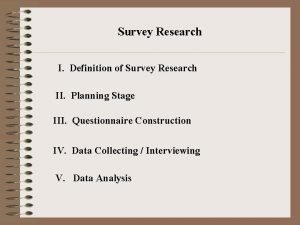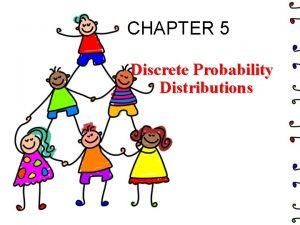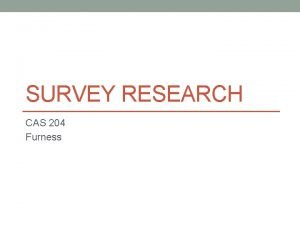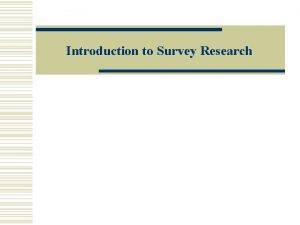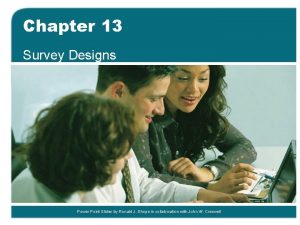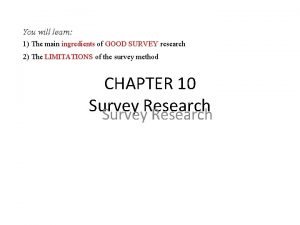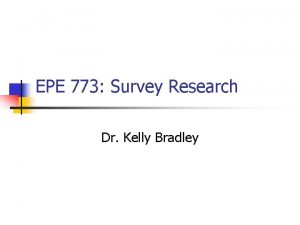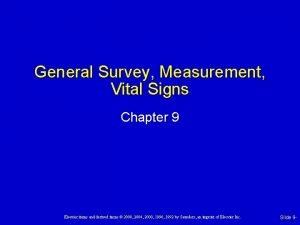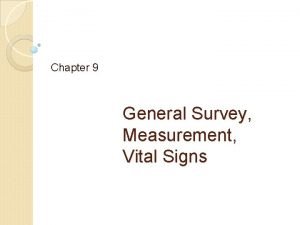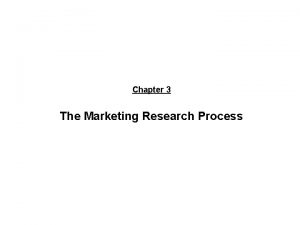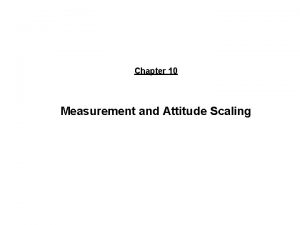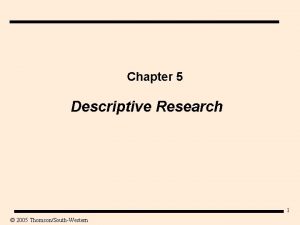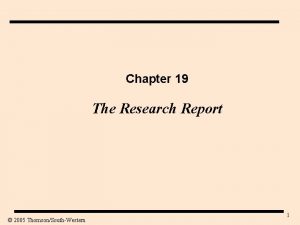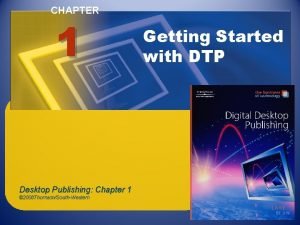Chapter 7 Survey Research An Overview 2007 ThomsonSouthWestern










































- Slides: 42

Chapter 7 Survey Research: An Overview © 2007 Thomson/South-Western. All rights reserved.

LEARNING OUTCOMES After studying this chapter, you should be able to 1. Define surveys, and explain their advantages 2. Describe the type of information that may be gathered in a survey 3. Identify sources of error in survey research 4. Summarize way researchers gather information through interviews 5. Compare the advantages and disadvantages of conduction door-to-door, mall intercept, telephone, and Internet interviews 6. Discuss the importance of pretesting questionnaires 7. Describe ethical issues that arise in survey research © 2007 Thomson/South-Western. All rights reserved. 2

The Nature of Surveys • Respondents Ø People who verbally answer an interviewer’s questions or provide answers to written questions. • Survey Ø A method of collecting primary data in which information is gathered by communicating with a representative sample of people. • Sample Survey Ø A survey that emphasizes contacting respondents who are a representative sample of the target population. © 2007 Thomson/South-Western. All rights reserved. 3

The Nature of Surveys (cont’d) • Survey Objectives: Type of Information Gathered Ø Surveys attempt to describe what is happening or to learn the reasons for a particular marketing activity. Ø Survey research is descriptive research: v Identifying characteristics of target markets v Measuring consumer attitudes v Describing consumer purchasing patterns Ø Surveys can be both quantitative and qualitative Ø Surveys can be designed to provide insights about causal explanations or to explore ideas. © 2007 Thomson/South-Western. All rights reserved. 4

The Nature of Surveys (cont’d) • Advantages of Surveys Ø Gathering information via surveys is: v Quick v Inexpensive v Efficient v Accurate v Flexible • Disadvantages Ø Potential Problems v Poor design v Improper execution © 2007 Thomson/South-Western. All rights reserved. 5

Errors in Survey Research • Random Sampling Error Ø A statistical fluctuation that occurs because of chance variation in the elements selected for a sample. • Systematic Error Ø Error resulting from some imperfect aspect of the research design that causes respondent error or from a mistake in the execution of the research. • Sample Bias Ø A persistent tendency for the results of a sample to deviate in one direction from the true value of the population parameter. © 2007 Thomson/South-Western. All rights reserved. 6

EXHIBIT 7. 1 Categories of Survey Errors © 2007 Thomson/South-Western. All rights reserved. 7

Respondent Error • Respondent Error Ø A category of sample bias resulting from some respondent action or inaction such as nonresponse or response bias. • Nonresponse Error Ø The statistical differences between a survey that includes only those who responded and a perfect survey that would also include those who failed to respond. © 2007 Thomson/South-Western. All rights reserved. 8

Respondent Error (cont’d) • Nonrespondents Ø People who are not contacted or who refuse to cooperate in the research. v No contacts: people who are not at home or who are otherwise inaccessible on the first and second contact. v Refusals: People who are unwilling to participate in a research project. • Self-Selection Bias Ø A bias that occurs because people who feel strongly about a subject are more likely to respond to survey questions than people who feel indifferent about it. © 2007 Thomson/South-Western. All rights reserved. 9

Response Bias • Response Bias Ø A bias that occurs when respondents either consciously or unconsciously tend to answer questions with a certain slant that misrepresents the truth. Ø When researchers identify response bias, they should include a corrective measure. © 2007 Thomson/South-Western. All rights reserved. 10

Types of Response Bias • Acquiescence Bias Ø A tendency to agree with all or most questions. • Extremity Bias Ø The tendency of some Individuals to use extremes when responding to questions. • Interviewer Bias Ø The presence of the interviewer influences respondents’ answers. • Social Desirability Bias Ø Bias in responses caused by respondents’ desire, either conscious or unconscious, to gain prestige or appear in a different social role. © 2007 Thomson/South-Western. All rights reserved. 11

Administrative Error • Administrative Error Ø Errors in research task results due to the improper administration or execution of the research task. v Data-processing error: incorrect data entry, incorrect computer programming, or other procedural errors during data analysis. v Sample selection error: improper sample design or sampling procedure execution. v Interviewer error: mistakes made by interviewers failing to record survey responses correctly. v Interviewer cheating: filling in fake answers or falsifying questionnaires by an interviewer. © 2007 Thomson/South-Western. All rights reserved. 12

Survey Research by Media • Surveys ask a respondent for information using verbal or written questioning. Ø There is no best form of survey; each form has advantages and disadvantages. • Communicating with Respondents Ø Personal interviews v Door-to-door v Shopping mall intercepts v Telephone interviews Ø Self-administered questionnaires v Paper surveys v Internet surveys © 2007 Thomson/South-Western. All rights reserved. 13

Media Used to Communicate with Respondents • Human Interactive Media Ø A personal form of communication that is a direct interaction between individuals or groups • Electronic Interactive Media Ø Controlled by user; provides immediate feedback v The Internet, CD-ROMs and DVDs, touch-tone telephones, touch-screen kiosks, and other forms of digital technology. • Noninteractive Media Ø Tradition forms with less flexibility v Self-administered © 2007 Thomson/South-Western. All rights reserved. mail and Internet surveys 14

Advantages of Personal Interviews Opportunity for Feedback High Participation Props and Visual Aids Personal Interviews Probing Complex Answers Length of Interview Completeness of Questionnaire © 2007 Thomson/South-Western. All rights reserved. 15

Disadvantages of Personal Interviews Lack of Anonymity of Respondent Interviewer Influence Personal Interviews Cost © 2007 Thomson/South-Western. All rights reserved. 16

Personal Interviews • Door-to-Door Interview Characteristics Ø Speed of data collection: moderate to fast Ø Geographical flexibility: limited to moderate Ø Respondent cooperation: excellent Ø Versatility of questioning: quite versatile Ø Questionnaire length: long Ø Item nonresponse: low Ø Possibility of respondent misunderstanding: lowest • Callbacks Ø Attempts to recontact individuals selected for a sample who were not available initially. © 2007 Thomson/South-Western. All rights reserved. 17

Personal Interviews (cont’d) • Door-to-Door Interview Characteristics Ø Degree of interviewer influence of answer: high Ø Supervision of interviewers: moderate Ø Anonymity of respondent: low Ø Ease of call back or follow-up: difficult Ø Cost: highest due to travel costs Ø Special features: visual materials may be shown or demonstrated; extended probing possible © 2007 Thomson/South-Western. All rights reserved. 18

Personal Interviews (cont’d) • Mall Intercept Interview (Shopping Center Sampling) Ø Speed of data collection: fast Ø Geographical flexibility: confined, urban bias Ø Respondent cooperation: moderate to low Ø Versatility of questioning: extremely versatile Ø Questionnaire length: moderate to long Ø Item nonresponse: medium Ø Possibility of respondent misunderstanding: lowest © 2007 Thomson/South-Western. All rights reserved. 19

Personal Interviews (cont’d) • Mall Intercept Interview (Shopping Center Sampling) Ø Degree of interviewer influence of answers: highest Ø Supervision of interviewers: moderate to high Ø Anonymity of respondent: low Ø Ease of call back or follow-up: difficult Ø Cost: Lower than door-to-door Ø Special features: taste tests, viewing of TV commercials possible © 2007 Thomson/South-Western. All rights reserved. 20

Personal Interviews (cont’d) • Global Considerations Ø Variations in willingness to participate v Sensitivity v Beliefs to interview subject matter about appropriate business conduct © 2007 Thomson/South-Western. All rights reserved. 21

Characteristics of Telephone Interviews • Speed • Cost • Absence of face-to-face contact • Cooperation • Incentives to respond • Representative samples • Call backs • Limited duration • Lack of visual medium © 2007 Thomson/South-Western. All rights reserved. 22

Types of Telephone Interviews • Central Location Interviewing Ø Conducting interviews from a central location using WATS lines at fixed charges. • Computer-Assisted Telephone Interviewing (CATI) Ø Allows answers to telephone interviews to be entered directly into a computer for processing. • Computerized Voice-Activated Telephone Interview Ø Combining computerized telephone dialing and voice-activated computer messages to allow researchers to conduct telephone interviews without human interviewers. © 2007 Thomson/South-Western. All rights reserved. 23

EXHIBIT 7. 2 Self-Administered Questionnaires Can Be Either Printed or Electronic © 2007 Thomson/South-Western. All rights reserved. 24

Self-Administered Questionnaires • Characteristics of Mail Questionnaires Ø Geographical flexibility Ø Cost Ø Respondent convenience Ø Anonymity of respondent Ø Absence of interviewer Ø Standardized questions Ø Time is money Ø Length of mail questionnaire © 2007 Thomson/South-Western. All rights reserved. 25

Mail Questionnaires • Response Rate Ø The number of questionnaires returned or completed divided by the number of eligible people who were asked to participate in the survey. • Factors that Bias the Response Rate Ø Persons who will complete questionnaires versus those persons who will not. Ø Person filling out survey is not the intended subject. © 2007 Thomson/South-Western. All rights reserved. 26

Increasing Response Rates for Mail Surveys • Cover letter • Money helps • Interesting questions • Follow-ups • Advance notification • Survey sponsorship • Other techniques • Keying mail questionnaires with codes © 2007 Thomson/South-Western. All rights reserved. 27

EXHIBIT 7. 3 Example of Cover Letter for Household Survey Source: Reprinted with permission of John Wiley & Sons, Inc. © 2007 Thomson/South-Western. All rights reserved. 28

Self-Administered Questionnaires (cont’d) • Fax Survey Ø A survey that uses fax machines as a way for respondents to receive and return questionnaires. • Advantages of the Fax Survey Ø Reduce sender’s printing and postage costs Ø Is quicker than traditional mail surveys • Disadvantage of the Fax Survey Ø Only respondents with fax machines who are willing to exert the extra effort will return questionnaires. © 2007 Thomson/South-Western. All rights reserved. 29

Self-Administered Questionnaires (cont’d) • E-Mail Surveys Ø Surveys distributed through electronic mail. Ø Benefits: v Speed of distribution v Lower distribution and processing costs v Faster turnaround time v More flexibility v Less handling of paper questionnaires Ø Potential Problems: v Anonymity of respondents creating response bias v Capacity of e-mail systems and computers v Computer skills/competencies of respondents © 2007 Thomson/South-Western. All rights reserved. 30

Self-Administered Questionnaires (cont’d) • Internet Surveys Ø A self-administered questionnaire posted on a Web site. v Respondents provide answers to questions displayed online by highlighting a phrase, clicking an icon, or keying in an answer. © 2007 Thomson/South-Western. All rights reserved. 31

Self-Administered Questionnaires (cont’d) • Internet Surveys Ø Speed and cost effectiveness Ø Visual appeal and interactivity Ø Respondent participation and cooperation v Varies depending on web site v Varies depending on type of sample v When user does not opt-in or expect a voluntary survey, cooperation is low. v Self-selection problems in web site visitation surveys: participants tend to be more deeply involved than the average person. © 2007 Thomson/South-Western. All rights reserved. 32

Internet Survey Design • Welcome Screen Ø The first web page in an internet survey, which introduces the survey and requests that the respondent enter a password or pin. Ø Can be compared to a cover letter Ø Should contain the name of the research company and how to contact the organization if there is a problem or concern. v Example: If you have any concerns or questions about this survey, or if you experience any technical difficulties, please contact (NAME OF RESEARCH ORGANIZATION). © 2007 Thomson/South-Western. All rights reserved. 33

Self-Administered Questionnaires (cont’d) • Internet Surveys (cont’d) Ø Representative samples Ø Accurate real-time data capture Ø Callbacks Ø Personalized and flexible questioning Ø Respondent anonymity Ø Response rates Ø Security concerns © 2007 Thomson/South-Western. All rights reserved. 34

Self-Administered Questionnaires (cont’d) • Problems with Internet Surveys Ø Not all individuals have internet access. Ø Respondents may lack powerful computers with high-speed connections to the internet. Ø Respondents’ computer skills may be relatively unsophisticated. © 2007 Thomson/South-Western. All rights reserved. 35

Selecting the Appropriate Survey Research Technique • Questions to be answered: Ø Is the assistance of an interviewer necessary? Ø Are respondents interested in the issues being investigated? Ø Will cooperation be easily attained? Ø How quickly is the information needed? Ø Will the study require a long and complex questionnaire? Ø How large is the budget? © 2007 Thomson/South-Western. All rights reserved. 36

EXHIBIT 7. 4 Advantages and Disadvantages of Typical Survey Methods © 2007 Thomson/South-Western. All rights reserved. 37

EXHIBIT 7. 4 Advantages and Disadvantages of Typical Survey Methods (cont’d) © 2007 Thomson/South-Western. All rights reserved. 38

Selecting the Appropriate Survey Research Technique (cont’d) • Pretesting Ø Screening procedure that involves a trial run with a group of respondents to iron out fundamental problems in the survey design. • Basic Ways to Pretest: Ø Screen the questionnaire with other research professionals Ø Have the client or the research manager review the finalized questionnaire Ø Collect data from a small number of respondents © 2007 Thomson/South-Western. All rights reserved. 39

Ethical Issues in Survey Research • The American Marketing Association’s code of ethics expresses researchers’ obligation to: Ø Protect the public from misrepresentation and exploitation under the guise of marketing research Ø Protect respondents’ right to privacy Ø Avoid the use of deception Ø Inform respondents about the purpose of the research Ø Maintain confidentiality and honesty in collecting data Ø Maintain objectivity in reporting data © 2007 Thomson/South-Western. All rights reserved. 40

Key Terms and Concepts • Respondent • Sample survey • Random sampling error • Acquiescence bias • Extremity bias • Interviewer bias • Systematic error • Sample bias • Respondent error • Social desirability bias • Administrative error • Data processing error • Nonresponse error • Nonrespondents • No contacts • Sample selection error • Interviewer cheating • Refusals • Self-selection bias • Response bias • Personal interview • Item nonresponse • Door-to-door interview © 2007 Thomson/South-Western. All rights reserved. 41

Key Terms and Concepts (cont’d) • Mall intercept interview • Telephone interview • Random digit dialing • E-mail surveys • Internet survey • Welcome screen • Central location interviewing • Computer-assisted telephone interview (CATI) • Self-administered questionnaire • Dialog boxes • Mixed-mode survey • Pretesting • Mail survey • Response rate • Cover letter • Drop-off method • Fax survey © 2007 Thomson/South-Western. All rights reserved. 42
 Acls secondary survey
Acls secondary survey Sots meaning in research
Sots meaning in research What is the sample size in qualitative research?
What is the sample size in qualitative research? Advantages of survey research
Advantages of survey research Survey research definition
Survey research definition Descriptive method research
Descriptive method research Advantages of observation
Advantages of observation Advantages of survey research
Advantages of survey research Chapter 5 discrete probability distributions
Chapter 5 discrete probability distributions Survey of literature
Survey of literature Descriptive survey research design
Descriptive survey research design Survey research advantages and disadvantages
Survey research advantages and disadvantages Introduction to a survey
Introduction to a survey Experience survey in exploratory research
Experience survey in exploratory research Characteristics of survey research
Characteristics of survey research Variables in survey research
Variables in survey research Structured interview
Structured interview Quantitative questionnaire
Quantitative questionnaire Survey research
Survey research Purpose of survey research
Purpose of survey research Sociometric test questionnaire
Sociometric test questionnaire Emt chapter 24 trauma overview
Emt chapter 24 trauma overview Chapter 14 medical overview
Chapter 14 medical overview Chapter 9 lesson 2 photosynthesis an overview
Chapter 9 lesson 2 photosynthesis an overview Chapter 12 selling overview
Chapter 12 selling overview Financial intermediaries
Financial intermediaries Chapter 1 overview of verb tenses
Chapter 1 overview of verb tenses Overview of personal finance chapter 1
Overview of personal finance chapter 1 Overview of the dentitions chapter 11
Overview of the dentitions chapter 11 Foundations in personal finance chapter 1 test
Foundations in personal finance chapter 1 test General features of animals
General features of animals Chapter 1 an overview of financial management
Chapter 1 an overview of financial management Chapter 17 overview elements and their properties
Chapter 17 overview elements and their properties Chapter 1 overview of financial statement analysis
Chapter 1 overview of financial statement analysis A survey of probability concepts chapter 5 solutions
A survey of probability concepts chapter 5 solutions Body structure general survey
Body structure general survey Normal vital signs for all age groups
Normal vital signs for all age groups A survey of probability concepts chapter 5 solutions
A survey of probability concepts chapter 5 solutions Research report vs research proposal
Research report vs research proposal Method vs methodology
Method vs methodology Research design for qualitative research
Research design for qualitative research Characteristics of conclusive research
Characteristics of conclusive research Define research scope
Define research scope


